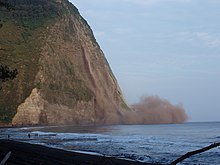


Waipiʻo Valley is a valley located in the Hamakua District of the Big Island of Hawaiʻi. "Waipiʻo" means "curved water" in the Hawaiian language.
The valley was the capital and permanent residence of many early Hawaiian Aliʻi (chiefs/kings) up until the time of King ʻUmi. This was a place celebrated for its nioi tree (Eugenia reinwardtiana) known as the Nioi wela o Paʻakalana ("The burning Nioi of Paʻakalana"). It was the location of the ancient grass palace of the ancient "kings" of Hawaiʻi with the nioi stands. The first chief who had a court in this valley was called Kahaimoelea. In the 18th century, Kahekili II (king of Maui) raided Waipiʻo and burned the four sacred trees to the ground.
The shore line in the valley is a black sand beach, popular with surfers. A few taro farms are located in the valley. Several large waterfalls fall into the valley to feed the river which flows from the foot of the largest falls at the back of the valley out to the ocean.
The valley floor at sea level is almost 2,000 ft (610 m) below the surrounding terrain. A steep road leads down into the valley from a lookout point located on the top of the southern wall of the valley. The road rises 800 feet (240 m) in 0.6 miles (1.0 km) at a 25% average grade, with significantly steeper grades in sections. Some portions of the road can reach up to a 45% grade, which would make Waipio Valley Road the steepest in the world, compared to Baldwin Street's 35%. This is a paved public road but it is open only to 4 wheel drive vehicles. It is the steepest road of its length in the United States.
A foot trail called Waimanu or Muliwai Trail leads down a steep path to the Waimanu Valley, which is only accessible by the trail or by boat. The trail is accessible to hikers, who need a Waimanu camping permit from the state unless they do the trek as a strenuous day hike. At the upper end of the valley, Waimanu Gap at 2,089 feet (637 m) elevation leads to the south end of Waimanu Valley.
Waipio Valley Road was closed to visitors from February 25, 2022 "as a precautionary safety measure and to further assess and mitigate the road’s conditions". Officials stated there was roadway and slope failure and the closure includes visitors both in vehicles and on foot.
On April 26, 2022, a group of Big Island residents announced they would be suing Mayor Mitch Roth and Hawaii County's Public Works Director Ikaika Rodenhurst over the closure of the road. The plaintiffs argued that the closure of Waipio Valley Road to all but residents violated their constitutional rights to equal protection against intentional and arbitrary discrimination. After mediation, the mayor amended the proclamation. The access to the valley floor with a covered 4WD vehicle was reopened September 19, 2022 for Big Island residents, county-permitted tour company operators and those seeking to practice their Native Hawaiian traditional or customary rights.
In Hawaiian folklore
It has a role in local Hawaiian folklore as a place where the gateway to Lua-o-Milu (the Underworld) was hidden from view by sand.
In popular culture
The valley was the site of the final scene in the 1995 sci-fi film Waterworld, at which the main characters found dry land.
References
- lookup of Waipiʻo on Hawaiian place names web site
- Hitt, Christine (April 21, 2019). "Learning Hawaii's history may be key to avoiding cultural insensitivity". Los Angeles Times. Retrieved April 22, 2019.
- History of the Waipiʻo Valley
- Russo, Carla Herreria. "The 10 Steepest Streets In America". HuffPost. BuzzFeed, Inc. Retrieved May 10, 2022.
- Jennings, Ken (October 20, 2014). "Is This Hawaiian Street the World's Steepest Road?". Condé Nast Traveler. Condé Nast. Retrieved February 19, 2022.
- "Waipio Valley Road in HI is the steepest road in the USA". Dangerous Roads. dangerousroads.org. Retrieved May 3, 2021.
- Baray, Alexa. "4 Steep U.S. Streets That Will Make Your Palms Sweat". Travel Trivia. Inboxlab, Inc. Retrieved May 10, 2022.
- Summerson, J: "The Complete Guide to Climbing (by Bike)", page 165. Extreme Press, 2007
- "Waipiʻo Valley Beach Hiking Trail | Hawaii Big Island Hikes". Go Hike It. July 1, 2017. Retrieved August 8, 2017.
- Lloyd J. Soehren (2004). "lookup of Waimanu Gap". on Hawaiian place names. Ulukau, the Hawaiian Electronic Library. Retrieved April 13, 2010.
- "Waipio Valley Road on the Island of Hawaii Closed to Visitors Indefinitely, Effective February 25". Hawaii Tourism Authority. Hawaii Tourism Authority. February 25, 2022. Retrieved May 10, 2022.
- "Mayor's 02/25/2022 Waipio Valley Road Emergency Rule No. 1". Mayor of Hawaii County. Retrieved February 27, 2022.
- Dobbyn, Paula (April 26, 2022). "Big Island Residents Sue Mayor And Public Works Director Over Waipio Road Closure". Honolulu Civil Beat Inc. Honolulu Civil Beat. Retrieved May 2, 2022.
- "Mayor's 09/16/2022 Waipio Valley Road Amended Emergency Rule No. 1". Mayor of Hawaii County. Retrieved September 28, 2022.
- Subiono, Russell; Harriman-Pote, Savannah; Tom, Emily; Rados, Krista (July 14, 2023). "The dispute over Waipiʻo Valley raises questions of belonging in Hawaiʻi". Hawai'i Public Radio. Retrieved July 15, 2023.
- Thrum, Thomas (1907). Hawaiian Folk Tales. A. C. McClurg. p. 12.
- Locations | Waterworld (1995) on IMDB
External links
20°7′11″N 155°35′36″W / 20.11972°N 155.59333°W / 20.11972; -155.59333
Categories: